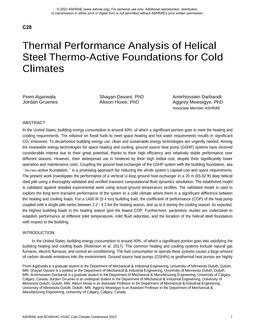Click here to purchase
In the United States, building energy consumption is around 40%, of which a significant portion goes to meet the heating and cooling requirements. The reliance on fossil fuels to meet space heating and hot water requirements results in significant CO2 emissions. To decarbonize building energy use, clean and sustainable energy technologies are urgently needed. Among the renewable energy technologies for space heating and cooling, ground source heat pump (GSHP) systems have received considerable interest due to their great potential, thanks to their high efficiency and relatively stable performance over different seasons. However, their widespread use is hindered by their high initial cost, despite their significantly lower operation and maintenance costs. Coupling the ground heat exchanger of the GSHP system with the building foundation, aka “thermo-active foundation,” is a promising approach for reducing the whole system’s capital cost and space requirements. The present work investigates the performance of a vertical U-loop ground heat exchanger in a 20 m (65.62 ft) deep helical steel pile using a thoroughly validated and verified transient computational fluid dynamics simulation. The established model is validated against detailed experimental work using actual ground temperature profiles. The validated model is used to explore the long-term transient performance of the system in a cold climate where there is a significant difference between the heating and cooling loads. For a 1406 W (0.4 ton) building load, the coefficient of performance (COP) of the heat pump coupled with a single pile varies between 2.2 – 4.3 for the heating season, and up to 6 during the cooling season. As expected, the highest building loads in the heating season give the lowest COP. Furthermore, parametric studies are undertaken to establish performance at different inlet temperatures, inlet fluid velocities, and the location of the helical steel foundation with respect to the building.
Product Details
- Published:
- 2023
- Number of Pages:
- 9
- Units of Measure:
- Dual
- File Size:
- 1 file , 1.8 MB
- Product Code(s):
- D-CCC23-28
- Note:
- This product is unavailable in Russia, Belarus
